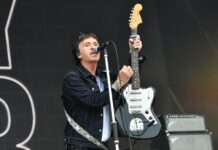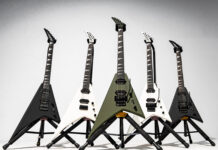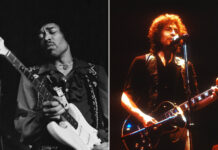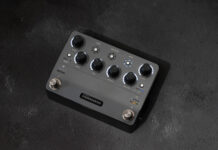
Private Collection: Cosmo’s otherworldly love for vintage Les Pauls
During his long career as a player with the likes of The Heavy Metal Kids, Curtis Knight, Andy Fraser and Phil Lynott among countless others, Cosmo has owned many historic instruments. It’s also a distinct possibility that he’s been playing vintage Les Pauls longer than practically anybody else in the UK, so catching up with him presents a rare opportunity to hear more about the pleasures and pitfalls of gigging and recording with some of the world’s most desirable vintage guitars.
Right away, we’re astonished to learn that Cosmo bought his first Burst in 1963, at the age of just 13 – and has never been without a vintage Les Paul since. “I’ve always played Bursts,” he explains. “The first one I got from McCormack’s Music in Glasgow. They weren’t very popular then, but I just loved it and it felt great. It was only about £100, although that was a lot of money at the time.
Note the seldom-seen original Selmer packaging“A friend called Fraser Watson had one and he was in The Poets, The Pathfinders and later, White Trash,” Cosmo recalls. “It was the first ’59 Burst I saw and played, and Fraser ended up selling it to his friend Danny Kirwan, around 1971.
“Before that, I had a ’59 ES-335, but that Burst was it for me. The sound was similar, but bigger, and it was more comfortable. I never really changed from there on; it was either a Burst or a three-pickup Custom. Although I did have an affair with a ’59 Flying V that lasted about 10 minutes.”
’59 varieties
Like the Keith Burst, the Tommy Burst was fitted with a Selmer-licenced Bigsby, which Cosmo removed and kept, of course.For a brief period, Cosmo owned one of the most iconic Bursts. “Around 1971, I was offered the Keith Richards Burst with the Bigsby. The guy didn’t want to just sell it to me, he actually wanted to swap it for a specific guitar. So, I went into Top Gear in Denmark Street and Sid Bishop managed to find me a ’59 ES-175 with PAFs that the guy wanted. It was a good deal, but remember Bursts were only worth around £225 in ’71. I kept the Keith Burst until mid 1974, when I damaged the neck. I dropped it and the neck slightly split up the back, but I was still playing it and it still stayed in tune. I ended up selling it to my mate Bernie Marsden, he then sold it and bought ‘The Beast’.” An entirely different ’59 Burst takes pride of place in Cosmo’s collection today, and although he has only owned it for a short time, his association with the instrument goes back decades.
“I was on tour with The Heavy Metal Kids and Humble Pie in 1973 and we were doing Green’s Playhouse in Glasgow. Somebody told me that there was another Burst in town that was owned by an older guy who was a great jazzer and singer. I said I’d be interested in seeing it and he brought it over. I thought it looked a lot like the Keith one, because it had a Bigsby and they’re only 20 digits apart. The owner’s name was Tommy Gibson and although I tried offering him £500 that night, he didn’t want to sell it. But over the years, we became friends and every year, I would try to buy it. Eventually, the zeros on the end began to build up and this went on for the next 30 years, until I moved house and lost Tommy’s number.”
Tommy Burst
1 of 5
Thankfully, fate intervened in the form of guitar-tech-to-the-stars, Alan Rogan. “He told me he thought the guitar had been offered to another collector. Fortunately, they hadn’t agreed terms and then Tommy’s son Craig found me through social media. He said Tommy had been looking for me and he was so upset, because he’d really wanted to sell me the guitar after all these years. The timing was good. I’m mates with Richie Sambora and I was going up to Glasgow the next day, as he was doing the O2. Anyway, as we were staying in the same hotel, I was just hoping Richie wouldn’t spot an old brown case come walking through reception! I took Tommy and Craig up to my room and I didn’t even negotiate. I just paid Tommy his price. I showed it to Richie at dinner afterwards and as you can imagine, his eyes lit up.”
Cosmo’s love of Bursts has brought him into contact with many of the most famous examples of the breed. The original sales documentation from the Tommy Burst shows it was one of the first two such guitars in the UKThe instrument’s pot codes indicate the 42nd week of 1959. Because the US/UK trade embargo was only lifted at the end of ’59, David Bower from Gibson UK is fairly sure the Tommy Burst was one of the first two Bursts in the UK. McCormack’s took delivery of both at the beginning of 1960 and Tommy bought it at the end of March. “Sadly, nearly a year after buying it from Tommy, I got a phone call from Craig telling me that Tommy had passed away,” Cosmo reveals.
Talks with Gibson Custom about producing a Collector’s Choice recreation of the guitar reached advanced stages, but unfortunately it wasn’t to be. “I wanted them to call it the Tommy Burst or ‘Glasgow Burst’, in his memory,” says Cosmo. “They said to me: ‘Looking at this guitar, we’ve got the rare inverted flame, the guy who first bought it was called Gibson and the serial number is 9-2222. You couldn’t make this up.’ I signed the contract – they decided to call the ‘Gibson Burst’, but that series was discontinued before it went into production.”
Tele tales
’56 Fender Esquire
1 of 6
Cosmo’s all-original ’56 Fender Esquire has a V-profile neck that gets more rounded towards the body end, and a single-ply pickguard
Setting the Burst aside for a moment, attention turns to a trio of vintage Fenders. “I like Teles, but I’m really an Esquire guy more than a Tele guy,” Cosmo tells us. “Mine is a ’56 and it has a V-profile neck that gets slightly rounder as you move up towards the body. I think Esquires sound better, I really do. They’re so simple and fortunately, this is all-original, including its untouched wiring harness.
’58 Fender Telecaster
1 of 4
Cosmo’s “awesome” 1958 Telecaster, which he’s owned since 2006
“I picked my ’58 Tele up a few years ago from a friend and I just think it’s awesome. It’s completely original and I love the way the ash grain shows up like blue veins. I’ve owned it since 2006 and it came in from America. I do love this one, it’s a monster guitar. It’s collector’s grade, but it’s more worn now than when I got it. Again, it’s all-original and sounds nice.
’60 Fiesta Red Fender Telecaster
1 of 3
This 1960
Fiesta Red Telecaster
has a transitional bridge
and a stunningly
well-preserved decal
“The Fiesta Red is extremely original. It’s a slab ’board from 1960 and although it’s a back loader, it has a top-loading bridge from that transition era of ’58-’59; Fender didn’t waste usable parts, so these bridges with two sets of holes were not depleted until the end of 1962. It’s interesting that the three Fenders here are from ’56, ’58 and ’60, but the necks all feel completely different – just like the Gibsons from ’56-’60 also all getting slimmer through the years. It makes you wonder who was watching who…”
So, it’s back to Bursts – and of all of those we’ve encountered, none has played better than Cosmo’s. Even so, it’s clearly a guitar that has seen a lot of use. “It has been played to death,” Cosmo agrees, “but the only thing I’ve done is remove the Bigsby and put its original stoptail and studs back on and had it re-fretted. The pickups and pots have never had a solder break and the pickup covers have never been off. It has a double white at the neck and zebra at the bridge. The Gibson guys loved the fingernail wear on the pickguard and neck-pickup surround. Tommy fitted a rare Bigsby around 1961 that Selmer made while under licence in the UK to distribute them. They look much like a standard B7, but are a few centimetres shorter, so the fixing screw could touch against the stud insert post for grounding. The Gibson guys hadn’t seen another one and I even have the original box it came in.”
Some kind of monster
Since Cosmo’s owned a number of Bursts, we ask how the Tommy Burst compares. “It’s a total monster,” he explains, “because it has such a big and wide sound. It’s so clear and when you’re going from chords to lead, every note is so clean and you don’t have to adjust. If you throw in a break, it just comes out. You don’t get that from reissues in the same way, or even 60s guitars. You don’t even get that from all the Bursts. But I don’t use pedals, so when I make a mistake, there’s no hiding. That’s the downside.
“Front pickups vary quite a lot as well,” Cosmo tells us. “Some are so overpowering, and others balance quite nicely. When they’re really good, they have that woody mellowness and harmonics, with the clarity. ”
The debate about what makes Bursts special is never-ending, but we welcome the opportunity to compare notes with someone whose opinions are based on decades of experience of gigging and recording with the real thing. “The pickups do make a difference, but if you were to put these PAFs in a new guitar and any repro pickups you like in my guitar, the old guitar is still going to sound better. It’s the wood, and not all of them were made with the same wood. Mine has earthy reddish Honduran mahogany, but sometimes, the colour looks more gold and those don’t sound as good. The earlier P-90 Goldtops tend to have the gold-colour mahogany, and even if you stick a couple of PAFs on them, they still don’t come up to it. ’58s tend to have the red mahogany and most of them sound really good, even if everybody wants a ’59,” Cosmo contends.
With its ‘poker chip’ and pickguard removed, the effect of UV light on the original finish is revealed“The Keith Burst and the ‘Greeny’ both have the red mahogany and they were all made close together in the 9-2000 batch, which is definitely the best by far, apart from a few ’58s.”
We wonder if Cosmo regards weight as a factor? “Heavier ones sound a bit harder,” he observes, “which is fine if you want to play metal, but I prefer lighter ones. I don’t believe Bursts sounded this good when they were new, because I feel the wood fuses over the years and gives you that harmonic effect. Some think it’s the PAFs, but I think it’s the wood. Just listen to the tone when it’s unplugged, that says it all.”
One of the PCAP-059 ‘Bumble Bee’ tone capacitors in situDespite being able to lay his hands on such stellar vintage instruments, pragmatism must occasionally prevail – and Cosmo sometimes plays a Les Paul replica, crafted by a renowned builder to his to specs. “I picked out every piece of wood on that guitar,” Cosmo points out. “It’s based on the Tommy Burst specs and even has the same asymmetrical neck profile. It’s got 50s PAFs, pots and Bumble Bees. The bridge is a 1960 ABR-1, because the retaining wire makes sense and it has a vintage tailpiece, scratchplate and knobs. The rings are his own replicas. I have to say, it sounds better than a lot of real Bursts. I have to look down sometimes to see what guitar I’m playing. With that one, it’s easy to forget.”
Vintage trouble
Much of the original ‘Les Paul’ silkscreen has worn awayOur time with Cosmo concludes with a topic that’s seldom discussed among originality-obsessed vintage-guitar enthusiasts – namely that we are dealing with very old guitars and many are showing signs of wear and tear. “What I’ve noticed in the last 10 years or so with a lot of vintage Les Pauls, is that the fingerboards have been so badly shot during various re-frets that it results in insufficient clearance between the strings and pickups when trying to set a comfortably low action,” Cosmo explains.
“You can usually tell how much has been taken off the ’board by the amount of brownness showing through the inlays. Some guitars have ended up with uncomfortably high action, just for the strings to clear the pickups. Other than back-veneering the original ’board and losing the original binding in the process, the only other solution is to take the ’board off a scrapped ’55 or ’56 Goldtop, if you can find one. It has to be from those years, because those ’boards are the only P-90 models with the right length.
Like so many vintage guitars, the Tommy Burst wears its history on its sleeve – or in this instance, on its scratchplate, where its jazz-playing custodian’s fingers gradually warped the plastic over time.“My luthier Andy Warnock has also had to pop glue under the ’boards of several Bursts and Goldtops because the ’boards are about to fall off,” Cosmo recalls, as he relates a cautionary tale for any prospective vintage Les Paul buyer. “I remember we first spotted this problem many years ago. It was a guitar that I’d had re-fretted a couple of times and it just wasn’t playing right. Andy started tapping on the ’board and realised that it was moving. He slid a blade under one end and the ’board just popped right off, with the binding intact. He reglued the ’board and the guitar was perfect. When you’re looking at any vintage Gibson, you might just want to check that the ’board is still firmly attached…”
The post Private Collection: Cosmo’s otherworldly love for vintage Les Pauls appeared first on Guitar.com | All Things Guitar.
Source: www.guitar-bass.net












